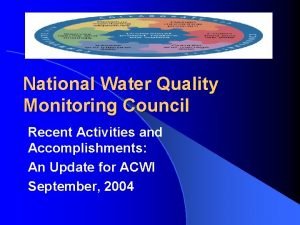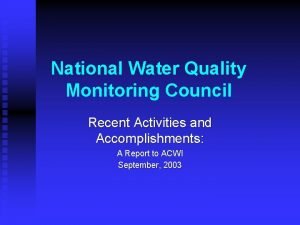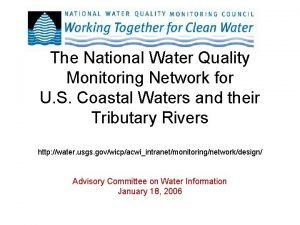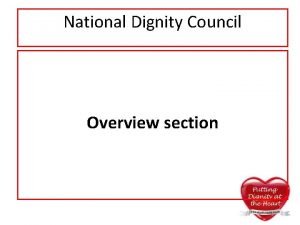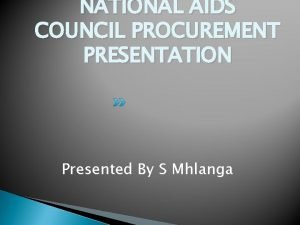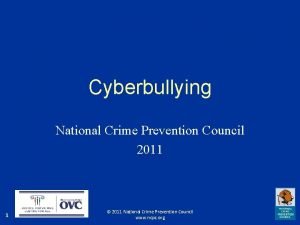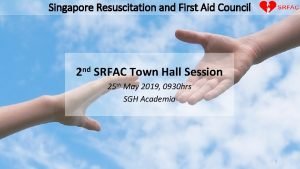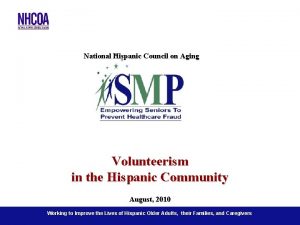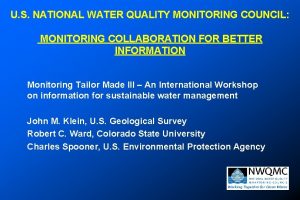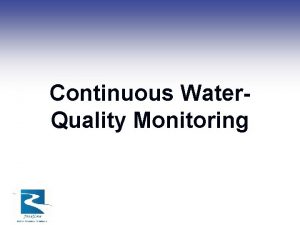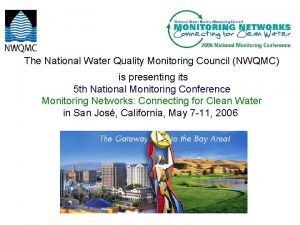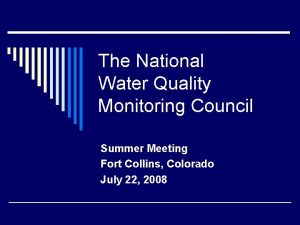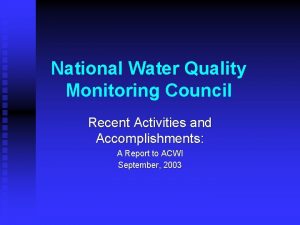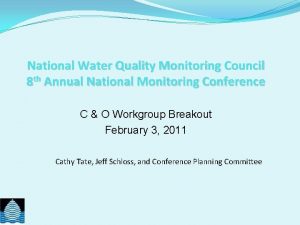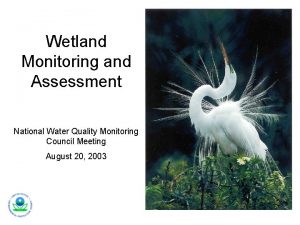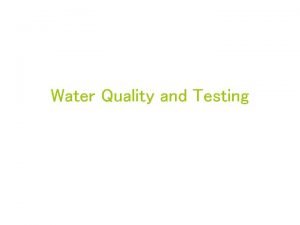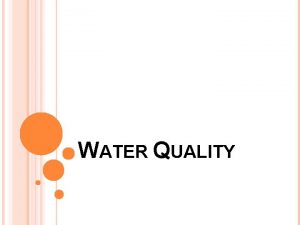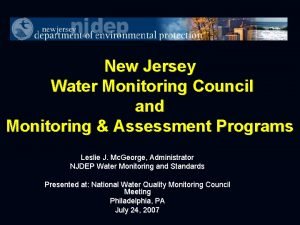National Water Quality Monitoring Council State Water Quality















- Slides: 15

National Water Quality Monitoring Council State Water Quality Assessments Under the Clean Water Act Charles Spooner Assessment and Watershed Protection Division Monitoring Branch 1

Module Objectives 303(d) Listing & TMDLs • Objectives: – Present a brief overview of assessment methodologies under Sections 303(d) and 305(b) of the CWA Discuss process of identifying impaired waters – Describe State reporting & submission options 2

Defines the water quality goal CWA Framework Compile data/information and assess waterbody condition 303(d) Program 40 CFR 130. 7 Implementation 3

WATER QUALITY STANDARDS …. what we’re aiming for Monitoring and Assessment Monitor Results WQS Implement TMDLs Report Water Quality & Identify Impaired Waters Develop TMDLs Write Permits 4

Regulatory Requirements Regulations (40 CFR 130. 7) Each State shall identify those water quality-limited segments still requiring TMDLs within its boundaries for which: – Technology based effluent limitations – More stringent effluent limitations – Other pollution control requirements Are not stringent enough to implement any water quality standards applicable to such waters 5

Regulatory Requirements Regulations (40 CFR 130. 7) For waters identified in the 303(d) list: – “TMDLs shall be established for all pollutants preventing or expected to prevent attainment of water quality standards…” – “TMDLs shall be established at levels necessary to attain and maintain the applicable narrative and numerical WQS…” 6

Regulatory Requirements Pollutant “Means dredged spoil, solid waste, incinerator residue, filter backwash, sewage sludge, munitions, chemical wastes, biological materials, (some) radioactive materials, heat, wrecked or discarded equipment, rock, sand, cellar dirt and industrial, municipal, and agricultural waste discharged into water. ” (CWA Sec. 502(6)) 7

State Options for Reporting WQ Status Minimally Required by Regulations Reporting Separate 305(b) & 303(d) Integrated Report A State’s Section 303(d) list is comprised of waters impaired or threatened by a pollutant, and needing a TMDL Recommended Reporting Format A single state developed report that integrates the reporting requirements of CWA Sections 303(d), 305(b) and 314 States submit their 303(d) list to EPA’s Integrated Report EPA for review/approval April 1, Guidance (IRG) developed for every 2 years (2006, 2008, etc). 2002, 2004, 2006 and 2008 reporting cycles (www. epa. gov/owow/tmdl/) 47 States are using the Integrated Report format 8

Five Reporting Categories For Each Assessment Unit (Segment) IRG Guidance Category Description 1 All designated uses (DU) met 2 Some, but not all, DUs met 3 Can not determine if any DUs met 4 Impaired/threatened –TMDL not needed 4 a TMDL completed 4 b TMDL alternative 4 c Non-pollutant causes 5 Impaired/threatened by pollutant –TMDL needed Section 303(d) List 9

Conceptual Example: Multiple Categories Segment start Segment end Designated Use 1 Use 2 Use 3 Use not supported TMDL completed Insufficient information Category 5 Category 4 a 10 Category 3

Listing Process National Picture of Assessed and Impaired Waters • Nationwide, % of waters assessed to see if water quality standards being met (2002 305(b) list): – – 19% of rivers/stream miles 37% Lakes/ponds/reservoirs acres 35% Estuarine square miles: 9% Great Lakes shoreline miles • Assessed waters that are impaired, by waterbody type: – – 45% Rivers/streams 47% Lakes/ponds/reservoirs 32% Estuaries 91% Great Lakes shoreline • Most of these waters will go on the 303(d) list 11

Summary Statistics Listing of Impaired Waters • Over 38, 000 listed segments, with one or more impairments • Approximately 64, 000 waterbody-pollutant combinations reported – Indication of TMDLs that will need to be completed • Top 5 causes of impairment (updated October, 2007) – – – Mercury: 13% Pathogens: 13% Sediment : 11 % Metals (other than Mercury): 10% Nutrients: 8% Low dissolved oxygen: 7% 12

TMDLs needed by pollutant type and number of TMDLs that have been developed Approx. 64, 000 TMDLs needed; over 26, 000 developed (10/2007) 13

Listing Process State driven process Listing of Impaired Waters 1. States identify waters not meeting WQS based on “all existing and readily available information” 2. States establish priorities for TMDLs on basis of the use and severity of problem 3. States develop schedule of TMDLs to be developed within 2 years 4. States provide long term plan – complete TMDLs 8 to 13 years from first listing 5. EPA has 30 days to approve or disapprove list submitted April 1 st of each even year – If EPA disapproves State list, EPA has 30 days to develop list for the State 14

Any Questions? 15
 National water quality monitoring council
National water quality monitoring council National water quality monitoring council
National water quality monitoring council Nwqmc conference
Nwqmc conference National water quality monitoring conference
National water quality monitoring conference Water and water and water water
Water and water and water water National unification and the national state
National unification and the national state National council of youth sports
National council of youth sports National employment law council
National employment law council National dignity council
National dignity council National council for special education
National council for special education National aids control council tenders
National aids control council tenders National crime prevention council cyberbullying
National crime prevention council cyberbullying Arts council national lottery project grants
Arts council national lottery project grants National science council taiwan
National science council taiwan Singapore first aid council
Singapore first aid council National hispanic council on aging
National hispanic council on aging
